[Repair Case] 2022 Mercedes-Benz GLE350e low-voltage power system cannot be charged
Posted by Tony Brown on
Brand: Mercedes-Benz
Model: GLE350e
System: Charging
Year model: 2022
Issue:
When the new car is in pre-delivery inspection (PDI), it is found that the instrument battery alarms, and the low-voltage power system cannot be charged.
Troubleshooting:
This fault was discovered in the PDI of the new car, the low-voltage system could not be charged, the battery warning light is illuminated.
The vehicle can be started, but it has been consuming power, up to -40A, and the high-voltage system is normal. No relevant DTCs were found in a quick test. Before diagnosing faults, we should first be familiar with the structural principles of the relevant systems of the model.
GLE350e is Mercedes-Benz's latest plug-in hybrid model, equipped with M274 engine, 20kWh high-voltage battery, 90kW motor, motor torque up to 440N m, pure electric driving up to 50km, equipped with AC and DC charging systems. The high-voltage system structure diagram is shown in Figure 1.
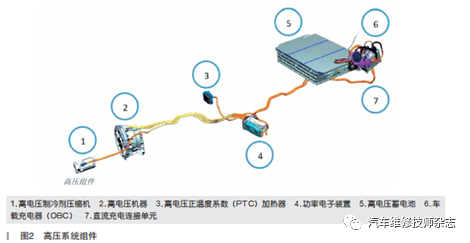
Figure 1
Further analysis of the structure diagram of the high-voltage system shows that the power electronic device is a very important device, and it has several functions: first, it plays the role of the starter control unit, which controls high-voltage machines, and can perform pure electric driving or for energy recovery, the power electronic device drives the motor by converting high-voltage direct current into high-voltage alternating current; secondly, it distributes high-voltage electricity to the compressor, and the compressor works on high-voltage electricity; thirdly, it distributes high-voltage electricity. Electricity is supplied to the high-voltage positive temperature coefficient (PTC) heater to control the heating of the high-voltage battery at low temperature; fourth, it plays the role of high-voltage to low-voltage conversion, that is, the role of generator, the role of DC/DC converter, the role of high-voltage turning to low pressure. This function can be reflected in the circuit diagram, as shown in Figure 2 to Figure 4.
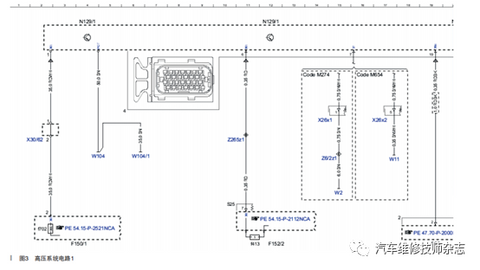
Figure 2
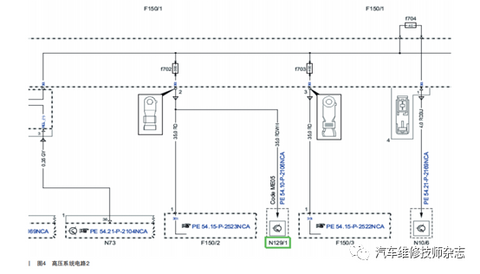
Figure 3
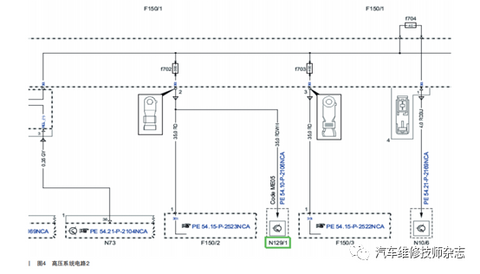
Figure 4
According to the circuit diagram, the motor A79/1 generates power to N129/1, which is converted to F150/1 through N129/1, and the battery is on F150/1, which is its power generation circuit.
After finding out its functional principle, we can then start the diagnosis. From the above principles, several possible reasons can be analyzed:
N129/1 power electronic control unit failure
N129/1 line failure
Since there is no fault code, we can only look at the actual value, and the actual value is all normal. Upgraded the battery unit, ignition switch, DC and AC charging units, and powered off again, but the fault remains the same. Further testing finds that the high voltage cannot be charged through the AC and DC charging ports. Check the actual value of the high-voltage battery, everything is normal, this is strange, where is the problem? Since N129/1 is an anti-theft component, it cannot be swapped, and the amount of work for swapping high-voltage batteries is too large, so the diagnosis was deadlocked. There are no specific guidelines in the technical report of the manufacturer. Here, the low voltage cannot be charged and the high voltage cannot be charged. Is there a connection between them? With this question in mind, we test the relevant components in the N129/1 and find an unexpected discovery.
The grounding resistance on the DC/DC converter in N129/1 cannot be determined. Compared with other vehicles, the test can determine the resistance of the DC/DC converter normally. It seems that there is a problem with the DC/DC converter in the N129/1. Check the grounding resistance and the equivalent resistance value of the N129/1, and they are normal. The equipotential resistance value here should be specially explained. The POT letter shown in Figure 5 is the equipotential line, which is to prevent accidental contact and electric shock of the human body after the high-voltage component is short-circuited. connected to discharge the high voltage. Figure 6 shows the physical map.
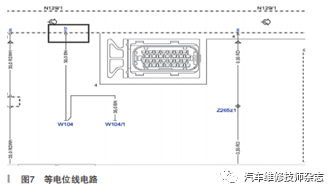
Figure 5

Figure 6
Replaced the N129/1 power electronic control unit, troubleshooting.
Summary: This plug-in hybrid model is the latest hybrid system of Mercedes-Benz. It has a lot of unknown technical features. In the face of faults without fault codes, it is also a good idea to check the actual value through the test of related components and find out some clues is a good diagnostic method.
